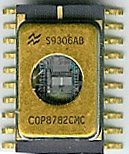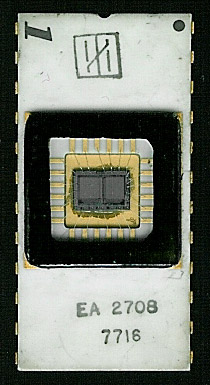February 23rd, 2009 ~ by admin
ARM today announced their new embedded microcontroller core. The next in the Cortex line. The M0 implements the standard ARM7 instruction set architecture, but manages to do so in only 12,000 gates. They did so by sacrificing performance for a smaller foot print and power savings. This certainly isn’t the first RISC CPU with such a small foot print. The XAP-RISC processor also manages to do so in 12,000 or so gates.
12,000 gates translates into around 50,000 transistors, which is about the footprint of the Intel 80186 processor. In today’s world of multi-million transistor ASIC’s you’ll see this ARM core everywhere (likely you wont even know its there) . To drop in a 12,000 gate block into a modern ASIC design is nothing, and the benefits can be amazing giving the 32 bit code base available for the ARM.
Source: EE Times
February 20th, 2009 ~ by admin
In a recent deal to try to solve their cash problems, and streamline profitability, Zilog sold off its secure transaction products (namely 32bit ARM processors) to Maxim (who through the purchase of Dallas, makes many MCS-51 controllers), They also sold off their wireless division to Maxim (and the software portion of this to a company called UEI)
What does this leave? Essentially the classic Z80 processor that has been around for the last 33 years, and all the related extentions there of. Old designs tend to stick around for a long time, and the Z80 is no exception.
Source: EE Times
February 16th, 2009 ~ by admin
CNet Blog nanotech recently did an article about the 3 most recent CPU design flops by Intel, IBM, and AMD.
For Intel they chose the Itanium, and Itanium 2, there is no doubt that the Itanic as it is commonly called was a failure of epic proportions. It cost to much, and ad NO decent backwards compatibility and no existing code base. Intel of course still keeps plugging away on it.
For AMD editor Brooke chose the Puma, AMD’s much hyped and highly underperforming CPU/GPU, no argument here, it was and is a dog.
Where I disagree is the selection of the PowerPC by IBM. While Apple’s use of the PowerPC (all 10 years of it) ultimately ended in failure, the PowerPC did find its niche in many industries. Servers and supercomputers worldwide use thousands of PowerPC CPU’s. IBM has created many embedded versions which are used in everything from industrial control to running printers. IBM has also successfully license the PowerPC architecture to many other companies (over 20 at that, including a couple CPU’s running on Mars). Xilinx makes FPGA’s with multiple integrated PowerPC cores which find there way into about everything. Apple continues to be involved in PowerPC through their purchase of PA Semiconductor.
Perhaps the most well known users of the PowerPC today? The Nintendo Wii and the XBOX 360.
February 14th, 2009 ~ by admin
National Semiconductors COP8 family of microcontrollers has been around for many years now, and with over a billion shipped, in thousands of configurations, will be around for quite some time.

COP8782CMC
This is a rather unusual COP8 used for development purposes. This is the first SOIC I have seen in ceramic, let alone with the UV Window.
February 11th, 2009 ~ by admin
Today two of the leading chip design companies for mobiles phones, media players, and other ‘connected’ devices merged. SiRF, widely known for their advanced low power GPS receivers and CSR, makers of some of the most widely used Bluetooth devices in the world.
CSR’s BlueCore line of chips integrate a XA-RISC controller, while SiRF’s latest offerings use an ARM7 core. The merger will allow them to build a single chip solution with wifi, bluetooth, and GPS, a device that is likely to find itself in about every connected device you can imagine. It will be interesting to see which processing core they stick with, though it is likely the final products will end up with both.
Source: SiRF Press Release
February 11th, 2009 ~ by admin
Electronic Arrays was born in the late 60’s back in the time of many start-ups (which mostly trace their roots back to Fairchild) EA attempted to make a CPU called the EA9002, but production problems kept them from going anywhere with it. They made EPROM’s likely to keep them afloat (and only 8k ones at that).

Electronic Arrays 2708
This EPROM was made in early 1977, less then a year later EA was bought out by NEC, now a world leader in electronics.
February 8th, 2009 ~ by admin
Last week we talked about Software Configurable Processors, and how they bridge the gap between general purpose CPU’s and FPGA’s. Yesterday a pair of them came in the mail.

Stretch S6000 & S6106
The S6100 is Stretch’s flagship product at this point (4 data ports full AIM interface and PCIe running at 345MHz). The S6106 is the low power device (2 data ports no AIM and no PCIe, clocked at 167MHz). This particular S6106 is an Engineering Sample. They are both based on the Xtensa VLIW core. (pic after the break)
Read More »
February 6th, 2009 ~ by admin
NEC has just announced one of the smalled ARM processors you will see. As mobile phones are getting more and more complex, more and better features are being added. In a smart phone such as the Blackberry Storm, or the iPhone, it is not uncommon to have 3 or 4 (or more) ARM cores in the design. NEC just added another. The new NEC CE143 is meant for one thing, running the camera on your phone. Most phone cameras have a 2 or so megapixel cam on them, some are heading towards 8+. The CE143 is meant for 12 megapixel cameras, and can record full 1080p HD video, on your phone. Check out the size of this:

NEC CE143 ARM mobile image processor
Tiny is right and that package includes 64MB of RAM and a MB of Flash
February 4th, 2009 ~ by admin
So I bought some chips on eBay, they arrived, and are New Old Stock, made in 2004, really fairly recent. I have a datasheet for them that is marked Winbond which I found rather strange, since the chips, as you can see are marked National. This in itself isn’t super unusual. Occasionally a smaller company will use a larger companies markings to get design wins. The larger company acts in essance like a co-signer, validating and approving of the design.

National PC97551
Winbond isn’t small though, and the datasheet was marked 2006. A quick look on Winbond’s site shows no info on this chip. Turns out Winbond spun off their controller business to a company called Nuvoton. And how did Winbond get the desgin? Yup, National sold off their Super I/O and embedded controller division to Winbond in 2005.
And it is of course a processor, in this case a 16bit RISC processor running at 20MHz based on the (formerly) National CompactRISC architecture.
February 3rd, 2009 ~ by admin
When designing a system, the best performance is often reached by using an ASIC, you can customize it to your design and tweak it for maximum performance. This, however, adds costly development time, and little flexiblility. You could use a general purpose processor; this saves dev time, and cost, but at the expense of performance. What if you could have both? Off the shelf processor technology, AND customizable speed.
You can. This is what Software Configurable Processors are designed for. In simple terms they are a standard CPU core, wrapped in a FPGA. This way istructions for the processort can be configured for maximun speed. If you have a function in your code that is repetitive, it can be reduced to a single instruction for the processor.

One of the leaders in Software Configurable Processors is called Stretch. Their S6000 line of processors use a Tensilica Xtensa core (a VLIW RISC design), wrapped in a custom FPGA. In this way the RISC core can be programmaed on the fly, providing much faster performance then a normal processor, or DSP.







